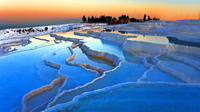Pamukkale Tour From Istanbul
Istanbul, Turkey
Trip Type: Day Trips
Duration: 17 hours
Pamukkale and Hierapolis Tour starts around 05:00 in the morning with pickup from hotel. After transfer to airport and flight to Denizli follows transfer to tour point. On the tour you will cherish visiting Domitian Gate, Colonnaded Gate, Cathedral, Red waters of Karahayit, Pamukkale Museum & The Travertine of Pamukkale. After the tour follows transfer to airport for flight to Istanbul and then follows transfer to hotel.
More About This Activity All Day Trips →
Pamukkale and Hierapolis Tour starts around 05:00 in the morning with pickup from hotel. After transfer to airport and flight to Denizli follows transfer to tour point. On the tour you will cherish visiting Domitian Gate, Colonnaded Gate, Cathedral, Red waters of Karahayit, Pamukkale Museum & The Travertine of Pamukkale. After the tour follows transfer to airport for flight to Istanbul and then follows transfer to hotel.Pamukkale and Hierapolis Tour starts around 5am in the morning with pickup from hotel. After transfer to airport and flight to Denizli follows transfer to tour point.
Enjoy relaxing soak in the hot springs of Hierapolis , one of the sacred sites of Turkey, dates back thousands of years and also admire the white limestone terraces, known as travertines of Pamukkale. Take a dip in the hot springs, which were used in Roman times because of their therapeutic powers. After breakfast, we set off for our Pamukkale and Hierapolis Tour. On the tour you will cherish visiting Domitian Gate, Colonnaded Gate, Cathedral, Red waters of Karahayit, Pamukkale Museum & The Travertine of Pamukkale. After the tour we take you to your hotel.
Pamukkale has always been a very popular settlement where the hot springs were. Hot springs are believed to have healing powers because of that city became the centre of a pagan cult in antiquity. Now it is outstanding spa resort.The city was on the borders of Caria, Lycia and Phrygia and had a mixed population. Citizens were usually involved in the wool and textile industry. The terraces were formed by running warm spring water, temperature is around 35 C, containing calcium bicarbonate. When the water loses its carbon dioxide it leaves limestone deposits. These are shows themselves with different colours and shapes in the form of terraces with pools, overhanging surfaces and fascinating stalactite formations. Pamukkale (cotton castle), takes its name from these formations.
According to scientists, if the water had always flowed at this rate, the terraces must have begun forming 14,000 years ago. A little further away from Pamukkale, near Karahayit village is another thermal spring, Kirmizi Su (the Red Water) has warmer water but less carbon dioxide gas where the running water creates a reddish effect different then the white cotton terraces of Pamukkale. Hierapolis, whose name means ‘sacred city’ , was believed by the Ancients to have been founded by the god Apollo. It was famed for its sacred hot springs, whose vapors were associated with Pluto, god of the underworld. During this tour you will see: Domitian Gate, Colannaded Gate, Cathedral, Hierapolis and Pamukkale were listed on the world Heritage sites of UNESCO in 1988. year.
Tour finishes around 4.00pm and we take you back to your hotel.
Enjoy relaxing soak in the hot springs of Hierapolis , one of the sacred sites of Turkey, dates back thousands of years and also admire the white limestone terraces, known as travertines of Pamukkale. Take a dip in the hot springs, which were used in Roman times because of their therapeutic powers. After breakfast, we set off for our Pamukkale and Hierapolis Tour. On the tour you will cherish visiting Domitian Gate, Colonnaded Gate, Cathedral, Red waters of Karahayit, Pamukkale Museum & The Travertine of Pamukkale. After the tour we take you to your hotel.
Pamukkale has always been a very popular settlement where the hot springs were. Hot springs are believed to have healing powers because of that city became the centre of a pagan cult in antiquity. Now it is outstanding spa resort.The city was on the borders of Caria, Lycia and Phrygia and had a mixed population. Citizens were usually involved in the wool and textile industry. The terraces were formed by running warm spring water, temperature is around 35 C, containing calcium bicarbonate. When the water loses its carbon dioxide it leaves limestone deposits. These are shows themselves with different colours and shapes in the form of terraces with pools, overhanging surfaces and fascinating stalactite formations. Pamukkale (cotton castle), takes its name from these formations.
According to scientists, if the water had always flowed at this rate, the terraces must have begun forming 14,000 years ago. A little further away from Pamukkale, near Karahayit village is another thermal spring, Kirmizi Su (the Red Water) has warmer water but less carbon dioxide gas where the running water creates a reddish effect different then the white cotton terraces of Pamukkale. Hierapolis, whose name means ‘sacred city’ , was believed by the Ancients to have been founded by the god Apollo. It was famed for its sacred hot springs, whose vapors were associated with Pluto, god of the underworld. During this tour you will see: Domitian Gate, Colannaded Gate, Cathedral, Hierapolis and Pamukkale were listed on the world Heritage sites of UNESCO in 1988. year.
Tour finishes around 4.00pm and we take you back to your hotel.
« Go Back

